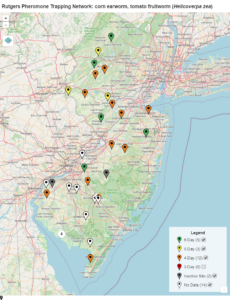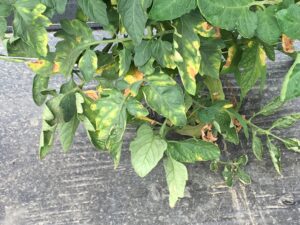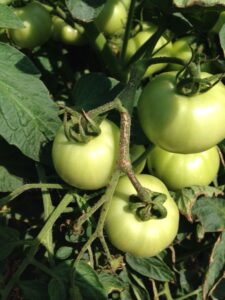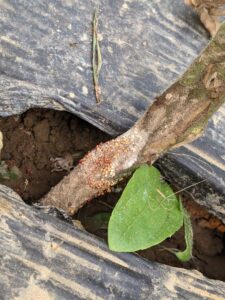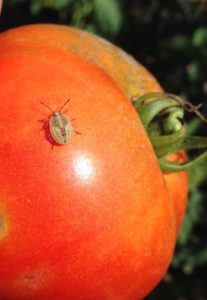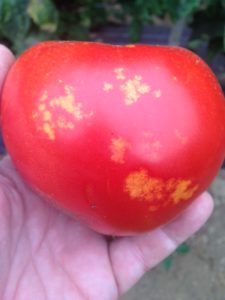Sweet Corn
European corn borer (ECB) moth catches are very low and scattered among blacklight traps in the northern and central counties. Larvae are absent from whorl and pre-tassel stage plantings. Should numbers rebound later in the summer, they will be reported in table form.
Fall armyworm (FAW) infestations are low and inconsistent in scouted fields north of Burlington County. At this time, field technicians are occasionally encountering small clusters of infested whorl stage plants, indicating that individual moths had entered fields and deposited eggs. Cooperating growers in Cape May County (where FAW is typically heaviest) report that FAW has thus far been largely absent from fields. Moths are showing up in blacklight traps occasionally, with slightly more individuals in coastal county sites. Because FAW moths are highly mobile, and with southerly winds dominating our weather lately, it is important to monitor fields at least weekly for signs of infestation. Whorl stage plants are prime targets for egg laying.
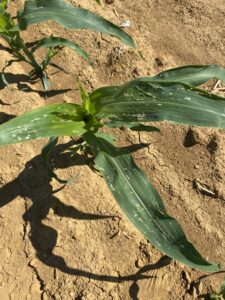 Newly hatched FAW larvae cause holes and scratches on leaves that are similar to ECB feeding, except that they tend to be more concentrated and always lead down into the whorl (see photo at left). As the larvae grow, the feeding becomes more destructive, with large ragged holes and obvious droppings deposited in the whorl (see photo at right).
Newly hatched FAW larvae cause holes and scratches on leaves that are similar to ECB feeding, except that they tend to be more concentrated and always lead down into the whorl (see photo at left). As the larvae grow, the feeding becomes more destructive, with large ragged holes and obvious droppings deposited in the whorl (see photo at right). 
We will provide updates on new FAW appearances and severity as reports come in. FAW are resistant to synthetic pyrethroids. Effective sprays should include IRAC grp. 5 (spinosyns) or IRAC grp. 28 (diamides). The carbamate (IRAC grp. 1A) Lannate is also still effective. Sufficient water should be used in the applications to allow the solution to penetrate the layer of droppings that may have formed above the caterpillar.
Corn earworm (CEW) moths captures from northern and central blacklight traps remain low, although there is a persistent scattered catch. Pheromone trap information is available from all northern and central sites, but is very limited this week from southern New Jersey. Overall, pheromone catches continue to decline. This week, pheromone traps in the New Egypt area of Ocean County and near Tabernacle in Burlington County were considerably higher than other reporting traps. Most pheromone traps registered a fairly low population of moths (see pheromone trap may below). Typically, CEW numbers decline through mid-July. We will use a combination of pheromone and blacklight trap types to derive silk spray schedules by region. Silking corn is at risk of CEW infestation at this time. Be sure to access information from this publication in the upcoming weeks to determine how frequently you should treat silking sweet corn to protect it from CEW infestation.
The highest nightly blacklight trap catches of CEW for the week ending 7/10/24 are as follows:
| Matawan 2 | Clinton 1 | Georgetown 1 |
| Bellemeade 1 | Farmingdale 1 | Milford 1 |
| Chester 1 | Hillsborough 1 | Milltown 1 |
The highest nightly pheromone trap catches of CEW for the week ending 7/10/24 are as follows:
| New Egypt 26 | Berlin 8 | Chester 5 |
| Tabernacle 25 | Snyder Farm (Hunterdon) 6 | Elm 5 |
| Georgetown 9 | Bellemeade 5 | Matawan 5 |
| Woodstown 9 | Califon 5 | Dayton 4 |
Using our current pheromone- based thresholds (30″ Hartstack trap) developed by the Univ. of Delaware, nightly corn earworm moth catches translate to:
0 moths – 6-7 day spray schedule
1 moth – 5 day spray schedule
2-20 moths – 4 day spray schedule
>20 moths – 3 day spray schedule
Silking Spray Schedules*:
South – 4 days
Central – 4 days
North – 4-5 days
*These recommendations are based on regional catches. Adhere to tighter spray schedules if indicated by local trap catches. Synthetic pyrethroids alone should NOT be used for corn earworm (CEW) protection on silking corn, or for fall armyworm (FAW) management at any stage. Control with these materials is very inconsistent.
Tomatoes
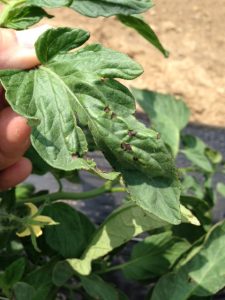 Bacterial leaf spot (BLS) and bacterial canker symptoms are beginning to appear in some scouted fields in central and northern counties. Symptoms of BLS infection include small, very dark lesions appearing on foliage of any age (see photo at left). Often even immature, unexpanded leaves are affected. Copper resistance in BLS populations in NJ has been identified. Bacterial canker is first characterized by marginal lesions on older foliage (photo below at left). These lesions work inward, ultimately killing entire leaves. Fruit lesions, also called bird’s eye spot (photo below at center) are initiated on very small fruit but become apparent as fruit enlarge. Dry lesions also may form on petioles (photo below at right). It is advisable that growers avoid working in fields when foliage is wet, to avoid easy spread of infections. Growers should also work from youngest blocks to oldest, to limit the chance of spreading disease to younger plants. Pruning, tying and harvesting are all ways that these diseases are dispersed throughout plantings. Bacterial infections in the field may be mitigated to some degree with systemic immune response activator Actigard, although results are often limited if weather and human activity favor spread. See the Tomato Section of the 2024/25 Commercial Vegetable Production Recommendations for further information.
Bacterial leaf spot (BLS) and bacterial canker symptoms are beginning to appear in some scouted fields in central and northern counties. Symptoms of BLS infection include small, very dark lesions appearing on foliage of any age (see photo at left). Often even immature, unexpanded leaves are affected. Copper resistance in BLS populations in NJ has been identified. Bacterial canker is first characterized by marginal lesions on older foliage (photo below at left). These lesions work inward, ultimately killing entire leaves. Fruit lesions, also called bird’s eye spot (photo below at center) are initiated on very small fruit but become apparent as fruit enlarge. Dry lesions also may form on petioles (photo below at right). It is advisable that growers avoid working in fields when foliage is wet, to avoid easy spread of infections. Growers should also work from youngest blocks to oldest, to limit the chance of spreading disease to younger plants. Pruning, tying and harvesting are all ways that these diseases are dispersed throughout plantings. Bacterial infections in the field may be mitigated to some degree with systemic immune response activator Actigard, although results are often limited if weather and human activity favor spread. See the Tomato Section of the 2024/25 Commercial Vegetable Production Recommendations for further information.
Southern blight has been found on a few farms in the scouting program this season. This fungal disease (Sclerotium rolfsii) causes rapid wilting and death of plants. Inspection of the main stem at the soil line reveals the presence of numerous spherical structures (sclerotia) adhering to the stem (see photo at right – courtesy of Rhea Bolar). This disease was once relatively uncommon in NJ, especially in northern counties, but exceptionally hot conditions with high soil moisture are contributing to it’s appearance. Little can be done once it appears. Tomatoes, peppers and vine crops should be avoided in fields with a history of this disease. Future plantings may be treated with the PCNB fungicide, Blocker in the transplant water. See the Tomato Section of the 2024-25 Commercial Veg. Recs. for details.
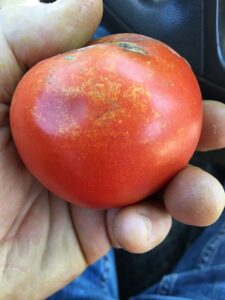 Thrips infestations continue in some high tunnels and fields. Hot weather can increase infestations. These
Thrips infestations continue in some high tunnels and fields. Hot weather can increase infestations. These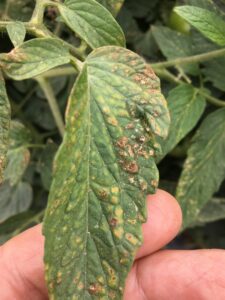 insects initially feed on foliage (see photo at right), and ultimately move to the surface of fruit, where they cause gold flecking to occur on ripening fruit (photo at left). While all “gold fleck” is not related to thrips, that which forms distinct rings and trails on fruit surfaces is caused by their feeding. Thrips can be difficult to manage due to insecticide resistance issues and their habit of hiding in blossoms and other tight spaces on the plants. It is best to apply control before populations become widespread in plantings. See the Tomato Section from the 2024-25 Guide for suggested insecticides.
insects initially feed on foliage (see photo at right), and ultimately move to the surface of fruit, where they cause gold flecking to occur on ripening fruit (photo at left). While all “gold fleck” is not related to thrips, that which forms distinct rings and trails on fruit surfaces is caused by their feeding. Thrips can be difficult to manage due to insecticide resistance issues and their habit of hiding in blossoms and other tight spaces on the plants. It is best to apply control before populations become widespread in plantings. See the Tomato Section from the 2024-25 Guide for suggested insecticides.

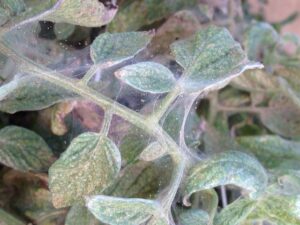 Two-spotted spider mite (TSSM) infestations are becoming more common in scouted tomato plantings. These pests multiply rapidly, and can cause severe defoliation under high temperature conditions if not detected early. Look for leaflets exhibiting pin spots (left) on the upper surface. These leaflets will become yellow as TSSM numbers increase. Mites may be observed on the underside of leaves showing these signs. Extreme infestations will result in extensive webbing being produced on top of foliage (right). Treatment should be undertaken when mites are first detected, because larger established infestations are quite difficult to control. Spot treatments may be effective if the infestation is limited. See the Tomato Section of the 2024-25 Commercial Veg. Recs. for details on effective materials.
Two-spotted spider mite (TSSM) infestations are becoming more common in scouted tomato plantings. These pests multiply rapidly, and can cause severe defoliation under high temperature conditions if not detected early. Look for leaflets exhibiting pin spots (left) on the upper surface. These leaflets will become yellow as TSSM numbers increase. Mites may be observed on the underside of leaves showing these signs. Extreme infestations will result in extensive webbing being produced on top of foliage (right). Treatment should be undertaken when mites are first detected, because larger established infestations are quite difficult to control. Spot treatments may be effective if the infestation is limited. See the Tomato Section of the 2024-25 Commercial Veg. Recs. for details on effective materials.
We are in the time of the season when native brown stink bugs become active in tomato fields. These true bugs (see photo of Euschistus sp. nymph below at left), move into irrigated tomato fields as forage in the surrounding environment dries out. Feeding results in “cloudy spot” (see photo at right below). Increases in stink bug injury are often found by crews picking the fruit. Growers should consider 1-2 insecticide applications to limit fruit injury if this damage is increasing in harvested fruit. If actively scouting fields, insecticides should be considered if stink bug adults, nymphs or new fruit injury is found in 2 or more sample sites in a 10 site sample. Insecticides that are effective on stink bugs include pyrethroids and neonicotinoids (see Tomato Section from the 2024-25 Guide), so care should be taken to avoid contact with foraging bees.
Brown Marmorated Sting Bug
Although the brown marmorated stink bug (BMSB) has not been much of a threat to vegetables in recent years, it is still a problem for tree fruit. We are currently experiencing adult generations for many stink bugs, and hot weather has increased activity. This is indicated by rising blacklight trap catches of BMSB. Catches range from 0 to 6/night across central and northern NJ.
Cucurbit Downy Mildew
Cucurbit downy mildew (CDM) has been detected on cucumber in Salem County as per Dr. Andy Wyenandt’s alert of 6/19/24. All cucumber growers should monitor fields for signs of this disease. Look for chlorotic areas bordered by veins on the upper leaf surface (photo at lower right). If conditions are moist, dark sporulation may be found on the lower leaf surface (photo at lower left).
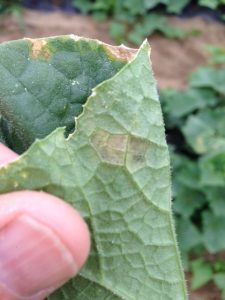
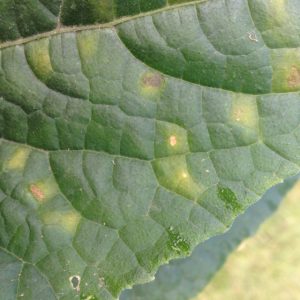 All cucumber and cantaloupe plantings should be protected. Useful materials for CDM may be found in the Cucumber Section of the 2024/25 Commercial Vegetable Production Recommendations. A sentinel plot is now established at Snyder Farm in Hunterdon County. This plot, consisting of pumpkin, watermelon, cantaloupe, butternut, acorn, cucumber and kabocha squash will be used to indicate the presence of cucurbit downy mildew in the region, and what crops are affected. As of 7/08/24, no CDM had been detected on any of these crops in the sentinel plot, nor in any scouted field in northern and central NJ. For regional information on this important disease, see the Cucurbit Downy Mildew webpage: http://cdm.ipmpipe.org/. Note that the forecast component of this site is not active. However, reports of CDM can still be found on the site, (although it appears there has been little participation lately!) and will appear on the homepage map down to county level, with associated host information.
All cucumber and cantaloupe plantings should be protected. Useful materials for CDM may be found in the Cucumber Section of the 2024/25 Commercial Vegetable Production Recommendations. A sentinel plot is now established at Snyder Farm in Hunterdon County. This plot, consisting of pumpkin, watermelon, cantaloupe, butternut, acorn, cucumber and kabocha squash will be used to indicate the presence of cucurbit downy mildew in the region, and what crops are affected. As of 7/08/24, no CDM had been detected on any of these crops in the sentinel plot, nor in any scouted field in northern and central NJ. For regional information on this important disease, see the Cucurbit Downy Mildew webpage: http://cdm.ipmpipe.org/. Note that the forecast component of this site is not active. However, reports of CDM can still be found on the site, (although it appears there has been little participation lately!) and will appear on the homepage map down to county level, with associated host information.
Thank you!
The Vegetable IPM Program wishes to thank the following Field Technicians, without whom much of the information presented weekly here would not be available:
Chris Cloutier
Hamna Khalid
Alexandra Suszko
